(click on image to enlarge)
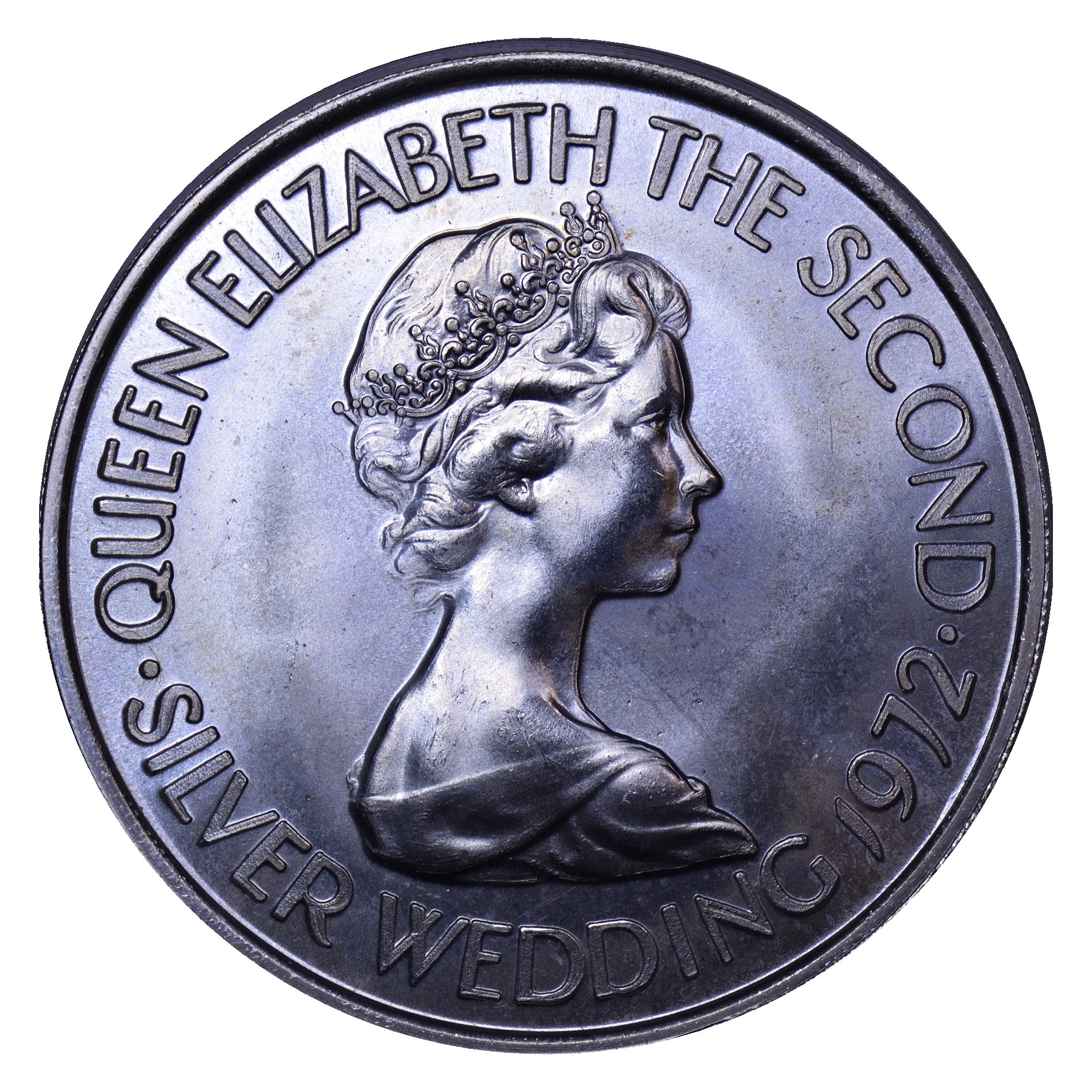
1972
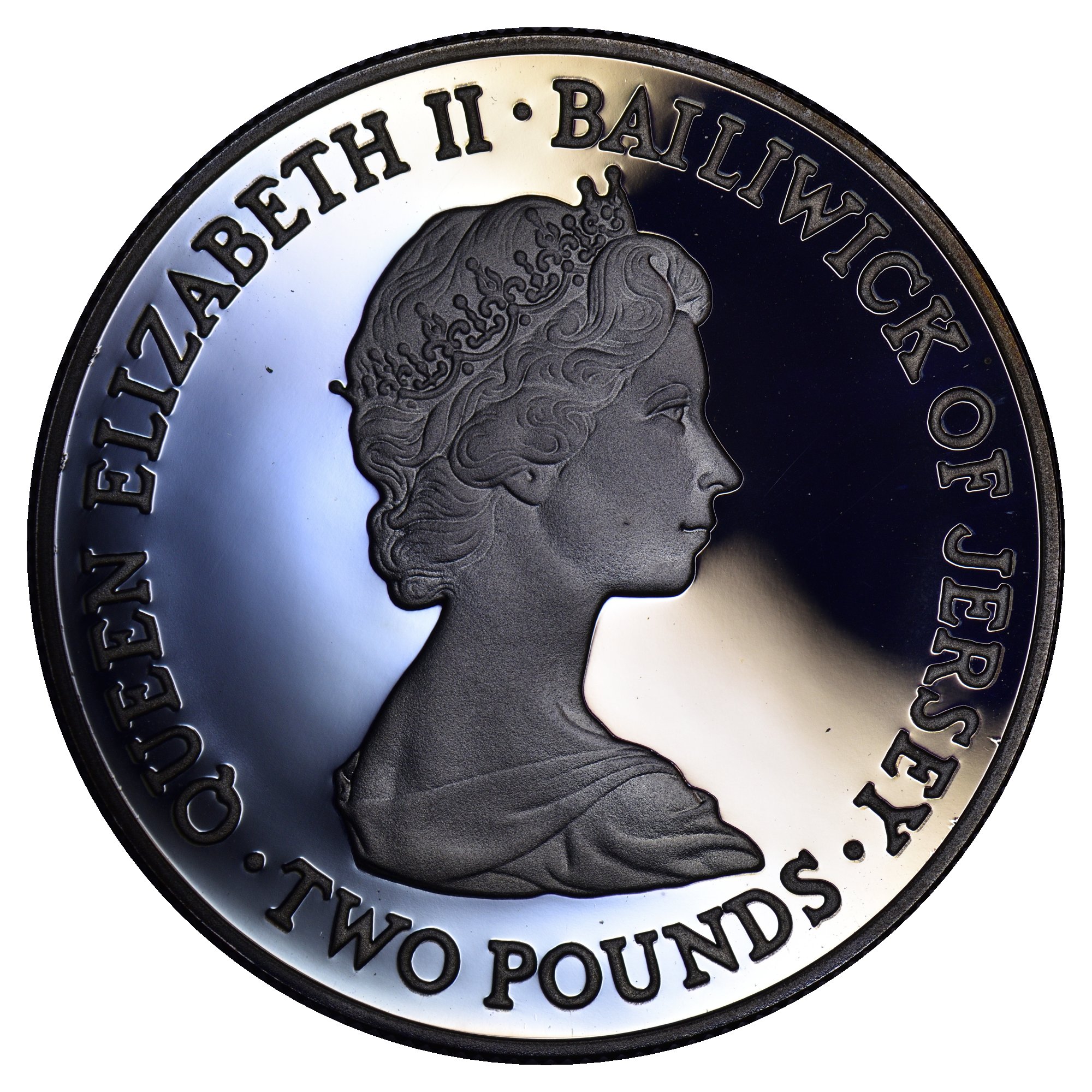
1981
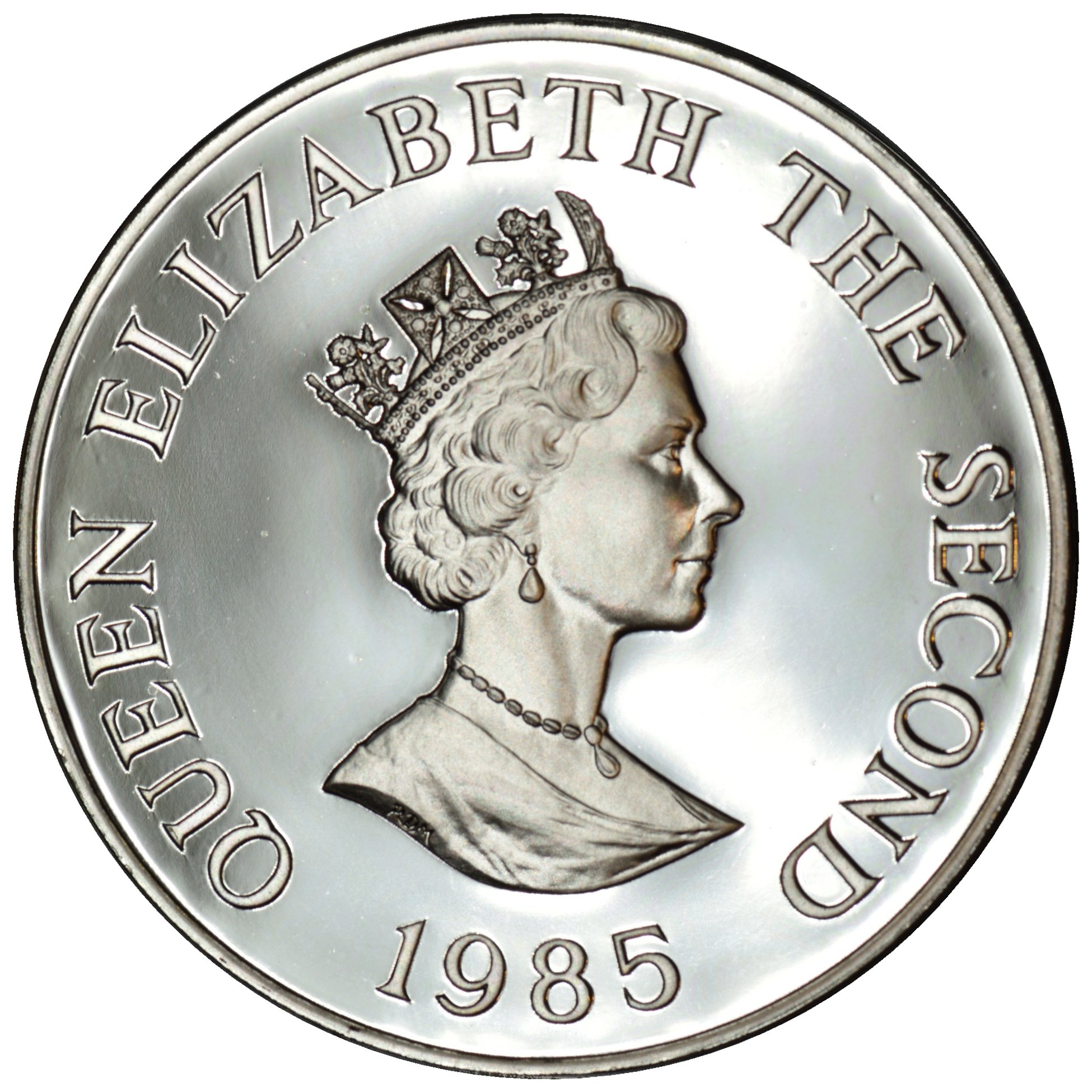
1985-1989 and 1995
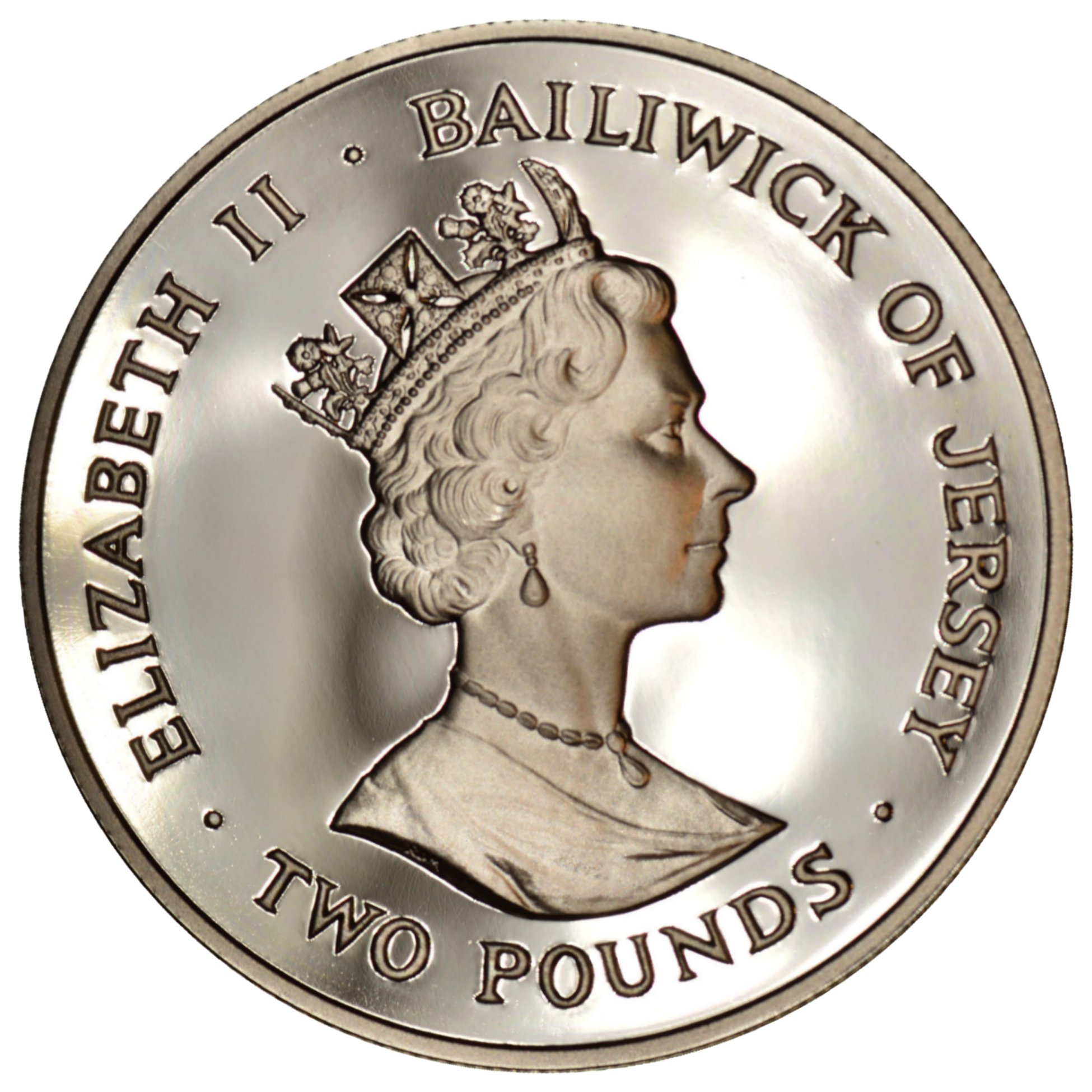
1990
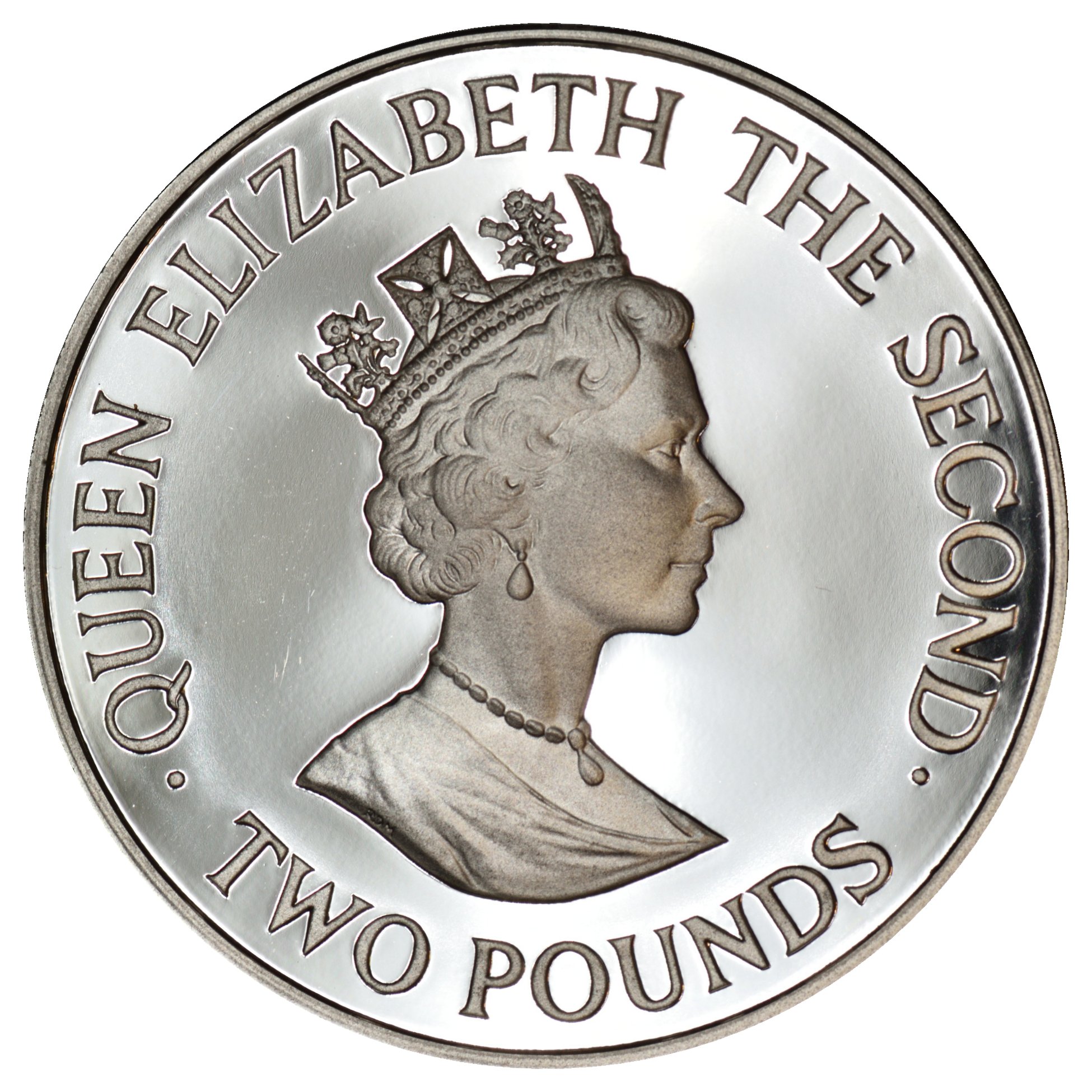
1993

1996
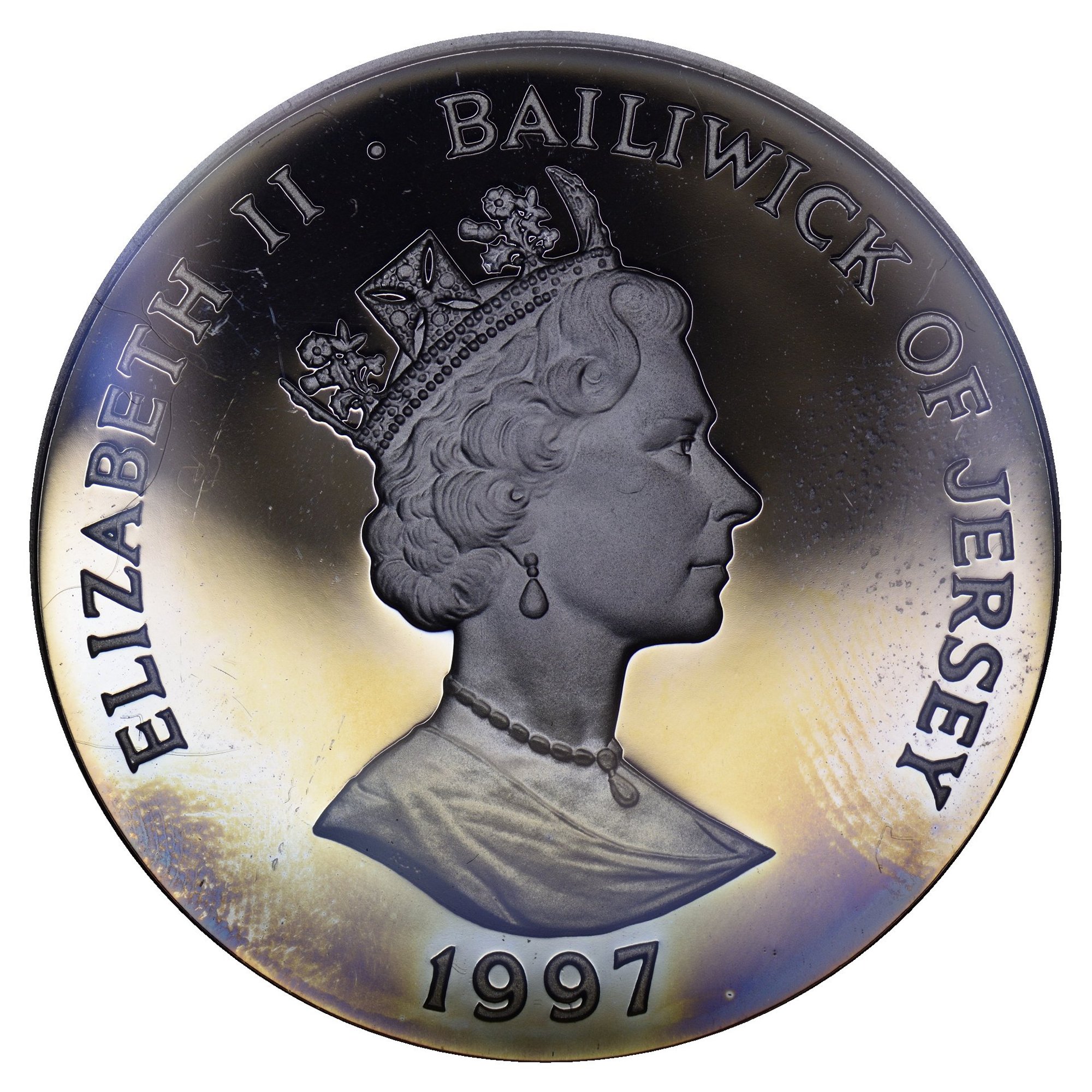
1997

2000
| Common Obverses (click on image to enlarge) | |
|---|---|
 1972 |
 1981 |
 1985-1989 and 1995 |
 1990 |
 1993 |
 1996 |
 1997 |
 2000 |
| Fifty Pence 25th Wedding Anniversary (click on image to enlarge) |
|---|
 |
YEAR KM diameter
1972 35 23.00
The Royal Mace of the Bailiff of Jersey,
borne before the Bailiff at the sittings of the Royal Court and of the Assembly of the States of Jersey,
was presented by King Charles II to Jersey on the 29th November 1663 in gratitude for the hospitality,
which he received from the Island on two occasions during his exile.
The mace consists of eleven pieces, made of silver gilt, is 4 ft. 9 ½ inches long,
weighs 237 ounces (14 lbs. 13 ozs.) and bears no hallmarks.
Engraved on the foot knop is a Latin inscription, which translated reads:
"Not all doth he deem worthy of such a reward Charles II, King of Great Britain, France and Ireland, as a proof of his royal affection towards the Isle of Jersey (in which he has been twice received in safety when he was excluded from the remainder of his dominions) has willed that this Royal Mace should be consecrated to posterity and has ordered that hereafter it shall be carried before the Bailiffs, in perpetual remembrance of their fidelity not only to his august father Charles I but to His Majesty during the fury of the civil wars, when the Island was maintained by the illustrious Philip and George de Carteret, Knights, Bailiffs and Governors of the said Island."Things to note:
|
All of the 1972 Royal Wedding commemoratives were minted at York Stampings Ltd. Birmingham.
The dies were cut by H.B. Sale Ltd., Birmingham while the blanks were prepared by Sheffield Smelting Co. Ltd.
An article in the Birmingham Daily Post of Thursday 05 July 1973 give details about the contract for these coins. The Royal Mint Advisory Committee discussed these coin at their 167th meeting on 30th November 1972. |
| One Pound 25th Wedding Anniversary (click on image to enlarge) |
|---|
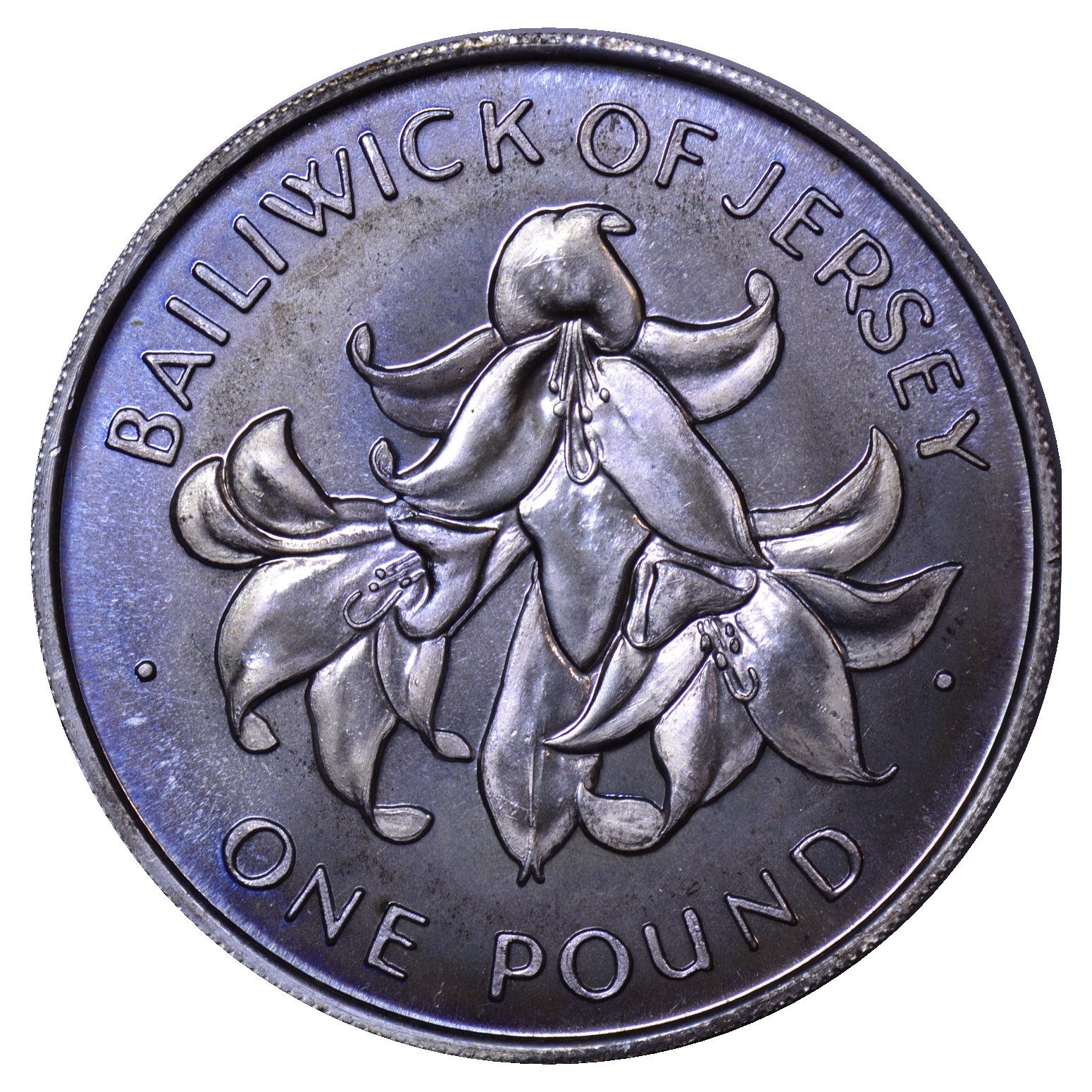 |
YEAR KM diameter
1972 36 30.00
Another coin for the Silver Wedding 1972 commemorative series.
The reverse, designed by Norman Sillman and modeled by the artist Terry George, has three florets of the Jersey Lily (Amaryllis belladonna).
| 25th Wedding Anniversary | |
|---|---|
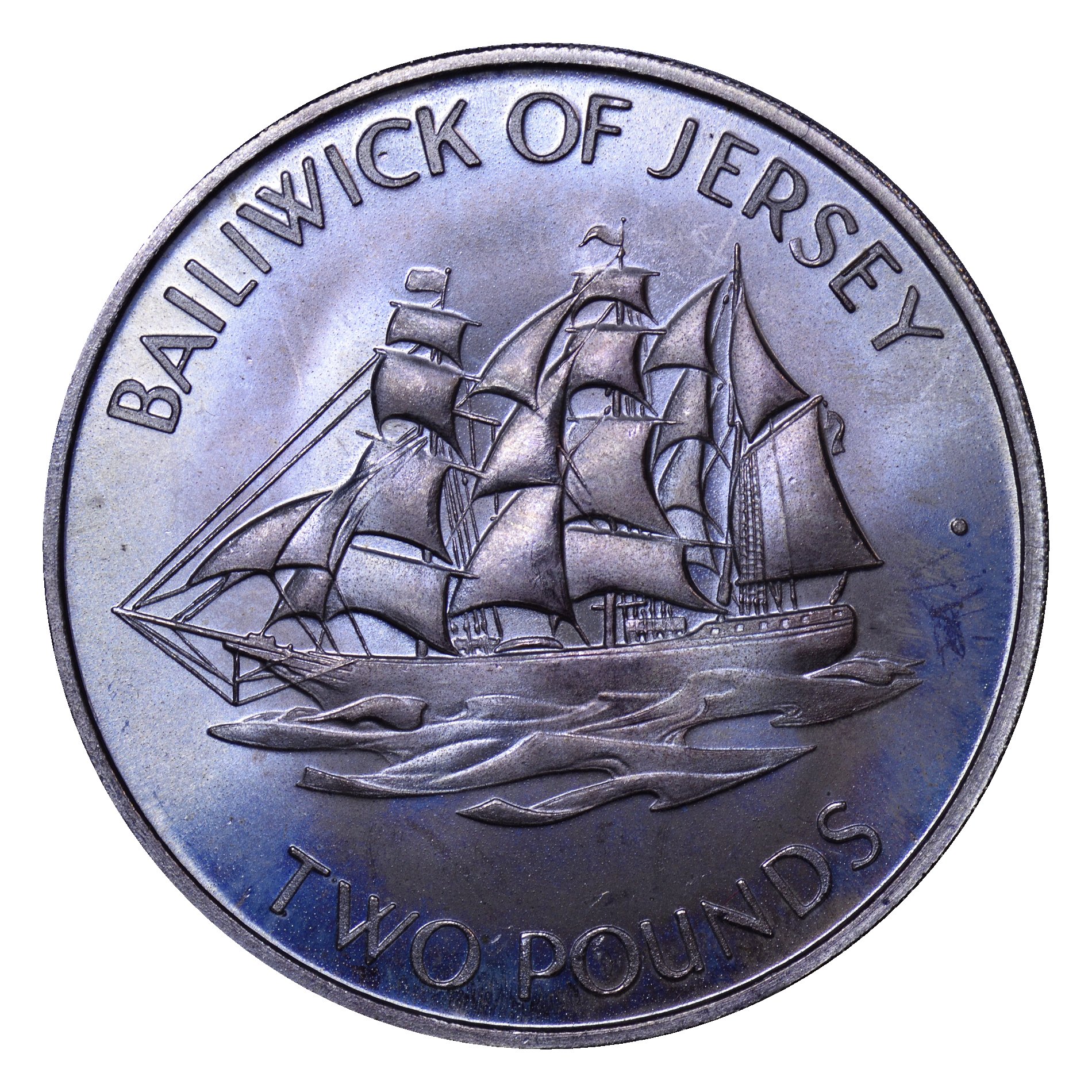 (click on image to enlarge) |
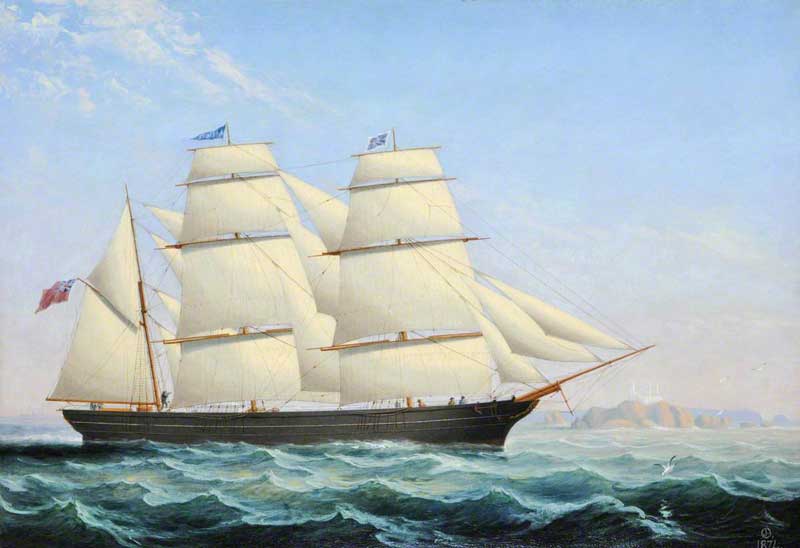
This painting by Philip John Ouless shows the Alexandra as a fully rigged barque with dark hull and with flags and a pennant. The Casquet lighthouses are in the background. |
YEAR KM diameter
1972 37 36.00
Like all of the Silver Wedding 1972 coins, this coin was designed by Norman Sillman and modeled by the artist Terry George. |
| Royal Wedding (click on image to enlarge) |
|---|
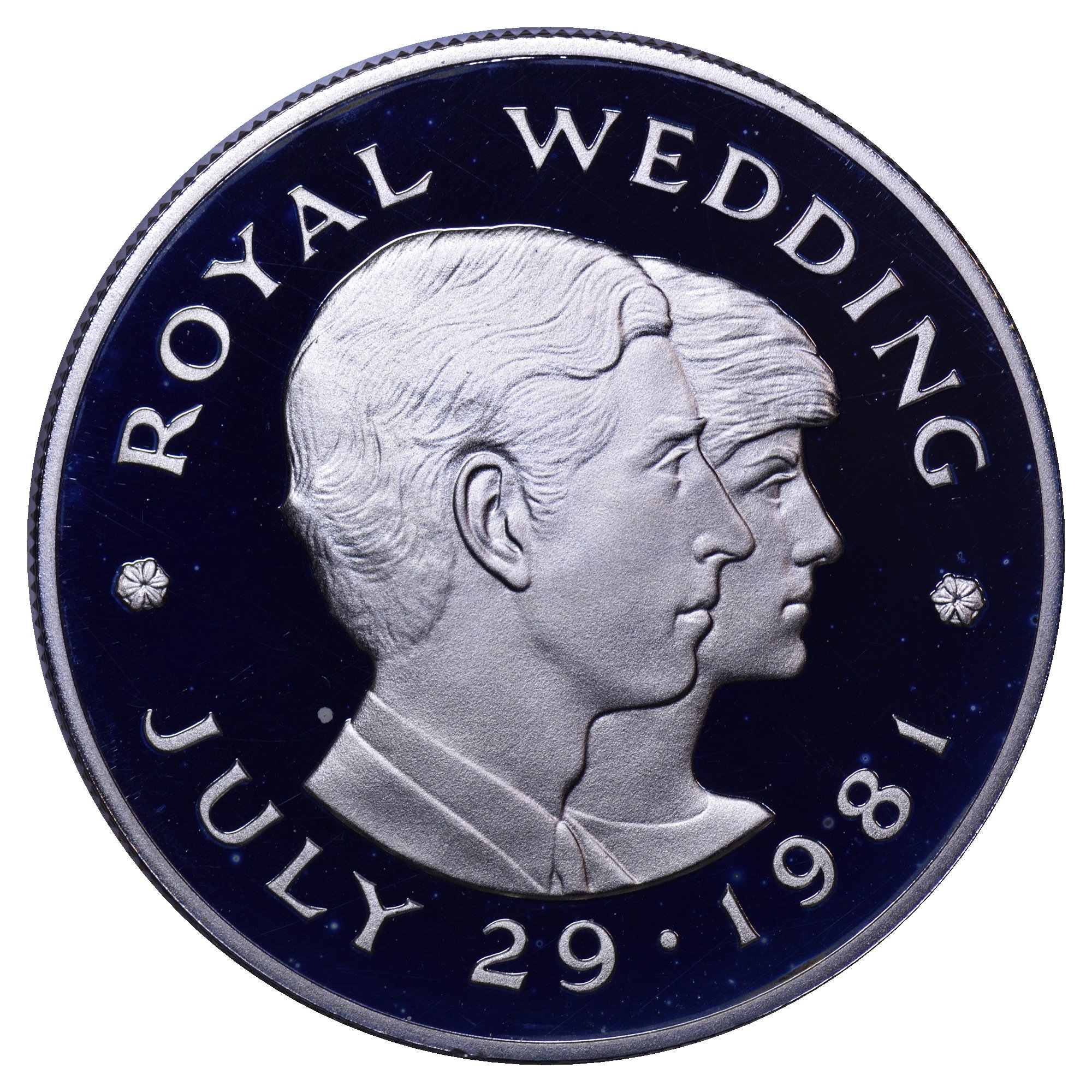 |
YEAR KM diameter
1981 52 38.61
Things to note about this series:
|
| 40th Anniversary of Liberation | |
|---|---|
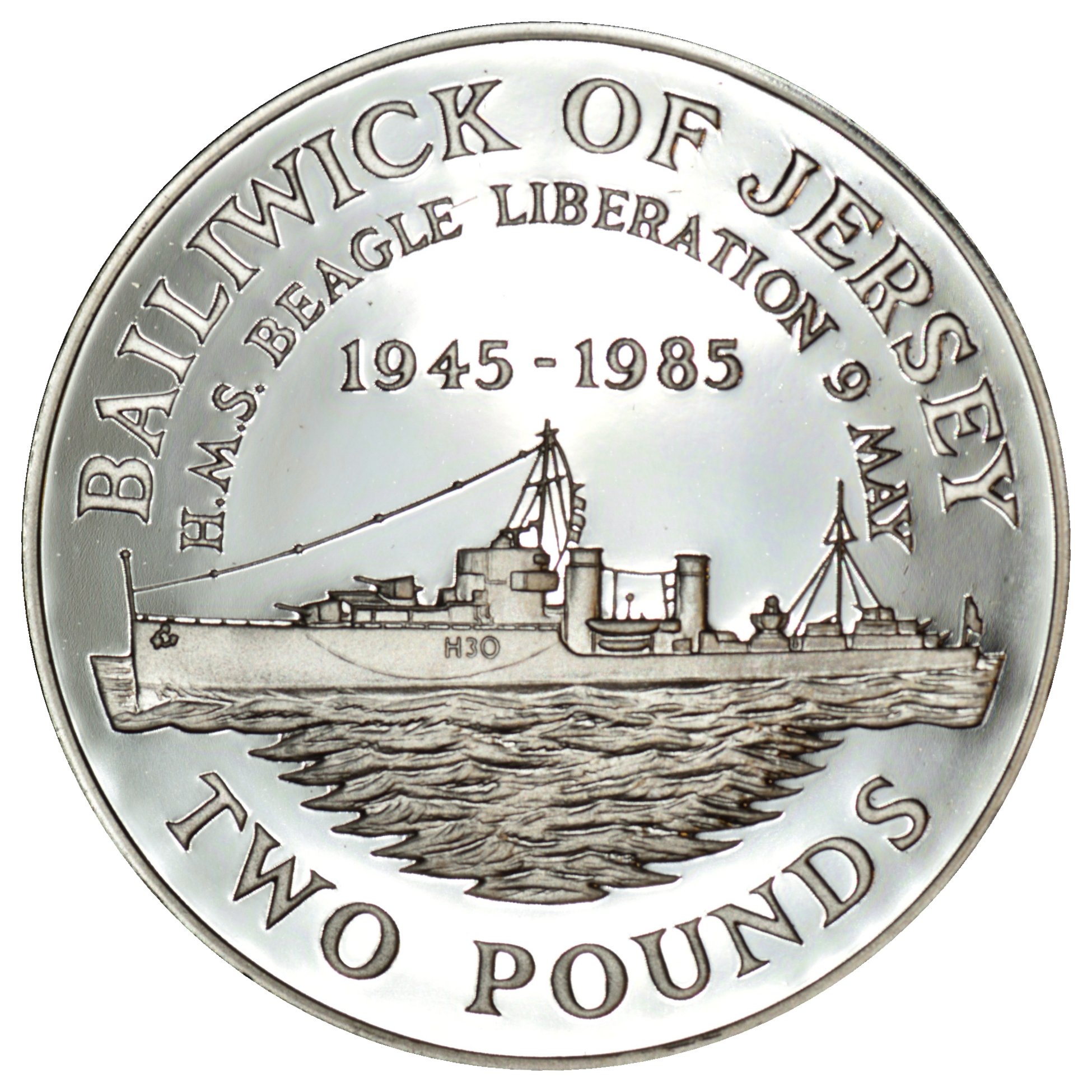 (click on image to enlarge) |
 The destroyer HMS BEAGLE |
YEAR KM diameter
1985 64 38.28
On the first of July 1940, the Island of Jersey was occupied by German troops
and became, along with the other Channel Islands, the only British soil to be occupied during the
Second World War. On the 9th of May 1945, a British force liberated the island and the German
Commanding Officer was taken aboard the H.M.S. Beagle where he signed terms of surrender.
The reverse design of this crown depicts the destroyer H.M.S. Beagle.
The edge of the coin bears an incuse inscription recalling Winston Churchill's words "Our dear Channel Islands will also be freed today."
| Some Initial Designs | A Letter by Ian Monins, States Coinage Advisor, with Several Ideas |
|---|---|
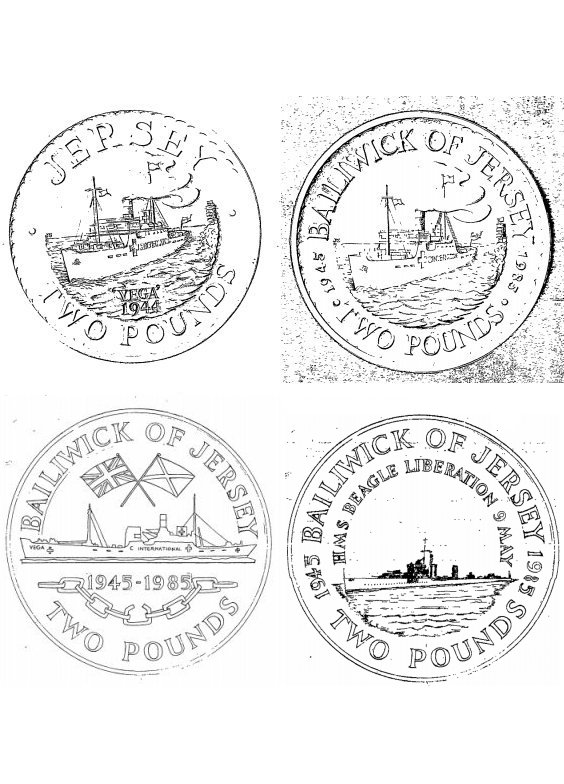 |
 |
| Some Initial Designs |
|---|
 |
| A Letter by Ian Monins, States Coinage Advisor, to John Kelly of the Royal Mint |
|---|
 |
| XIII Commonwealth Games Edinburgh (click on image to enlarge) |
|---|
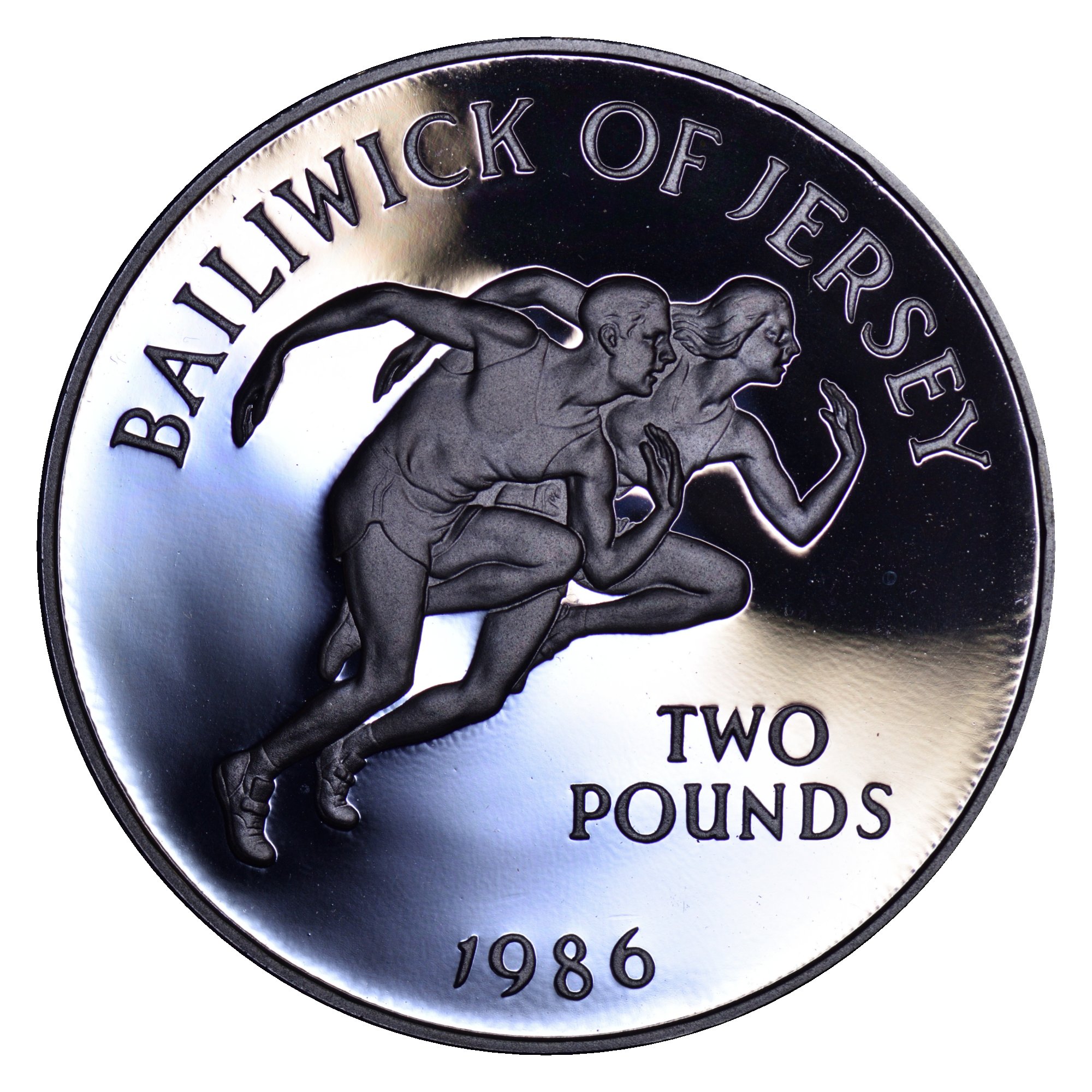 |
YEAR KM diameter
1986 67 38.28
Twenty six countries sent 1,662 athletes and 461 officials. These countries were Botswana, Malawi, Lesotho, Swaziland, Australia, Falkland Islands, Canada, Cayman Islands, Cook Islands, England, Fiji, Gibraltar, Guernsey, Hong Kong, Isle of Man, Jersey, Maldives, Malta, New Zealand, Norfolk Islands, Northern Ireland, Scotland, Singapore, Wales, Western Samoa, and Vanuatu. Things to note:
|
| World Wildlife Fund Mauritius Pink Pigeon | |
|---|---|
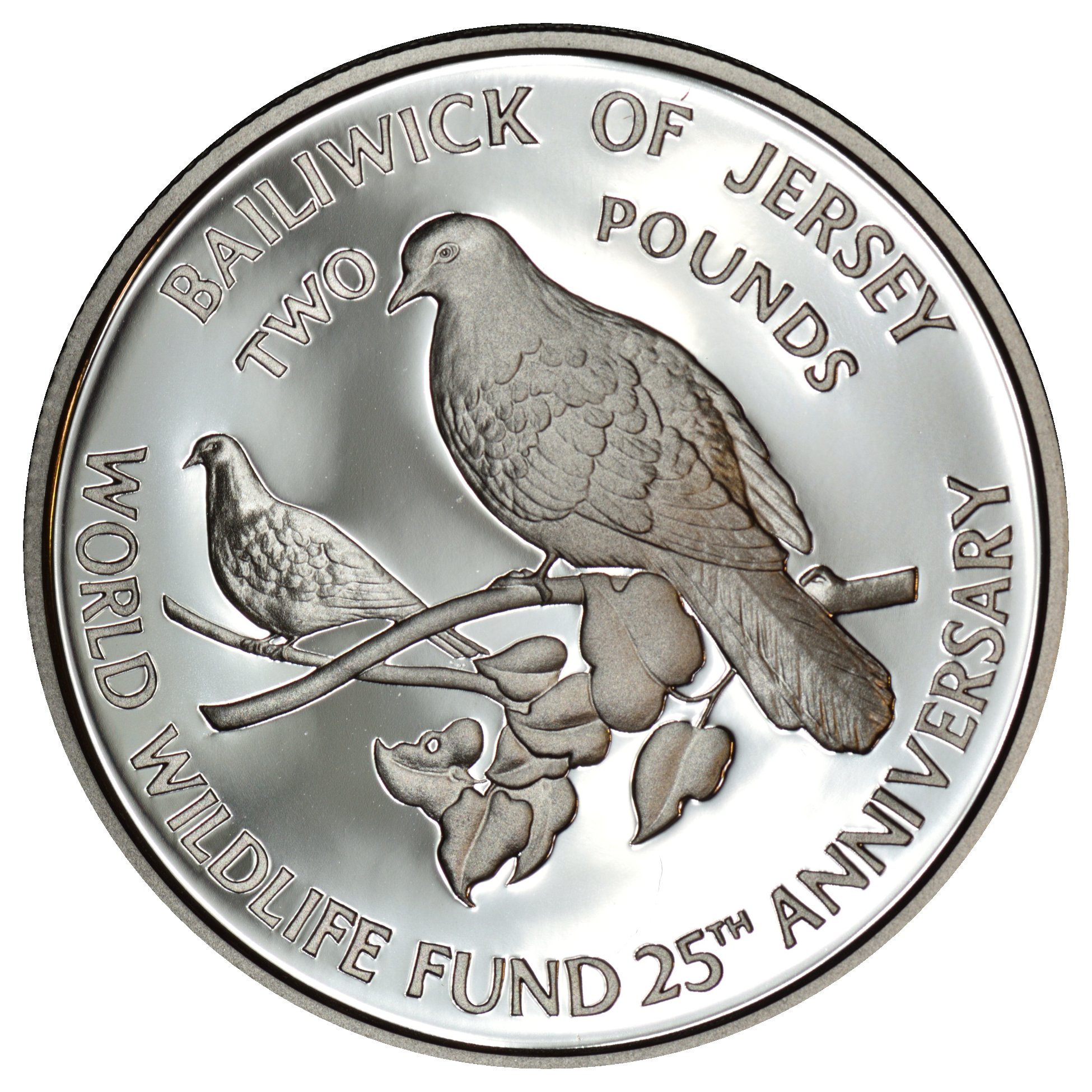 (click on image to enlarge) |
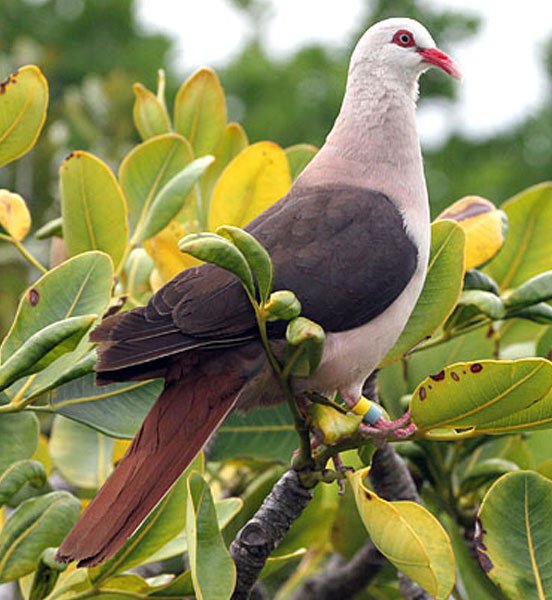 |
YEAR KM diameter
1987 70 38.61
The Pink Pigeon (Nesoerias mayeri) is a native of the island of Mauritius in the Indian Ocean. It is one of the rarest birds in the world with a population of only 15 in the wild. Without help from the Jersey Wildlife Preservation Trust (JWPT) it would soon have been totally extinct.
The JWPT was established in 1963 by the eminent zoologist and author Gerald Durrell. It is devoted to the concept of captive breeding of endangered species as an aid to their survival in the wild. In 1984 Gerald Durrell released the first 11 of 150 captive bred Pink Pigeons into the Pamplemousse Botanical Gardens in Mauritius as the first step of a major re-introduction programme to save the species.
The Pink Pigeon is named for its beautiful coloring. It has a light pink head,
neck and under parts with a darker pink back and wings and a bright chestnut colored tail.
| Royal Visit (click on image to enlarge) |
|---|

|
YEAR KM diameter
1989 76 38.28
"Not all doth he deem worthy of such a reward Charles II, King of Great Britain, France and Ireland, as a proof of his royal affection towards the Isle of Jersey (in which be has been twice received in safety when he was excluded from the remainder of his dominions) has willed that this Royal Mace should be consecrated to posterity and has ordered that hereafter it shall be carried before the Bailiffs, in perpetual remembrance of their fidelity not only to his august father Charles I but to His Majesty during the fury of the civil wars, when the Island was maintained by the il1ustrious Philip and George de Carteret, Knights, Bailiffs and Governors of the said Island." Things to note:
|
| 50th Anniversary of the Battle of Britain (click on image to enlarge) |
|---|
 |
YEAR KM diameter
1990 77 38.61
Fifty years ago, the skies over southern England became the fighting arena for those British airmen whom Churchill dubbed "The Few." At a crucial stage of the war, they answered the challenge to contest the mastery of the air. Their victory was shadowed by tragic losses. One in three never returned.
| The Initial Design | |
|---|---|
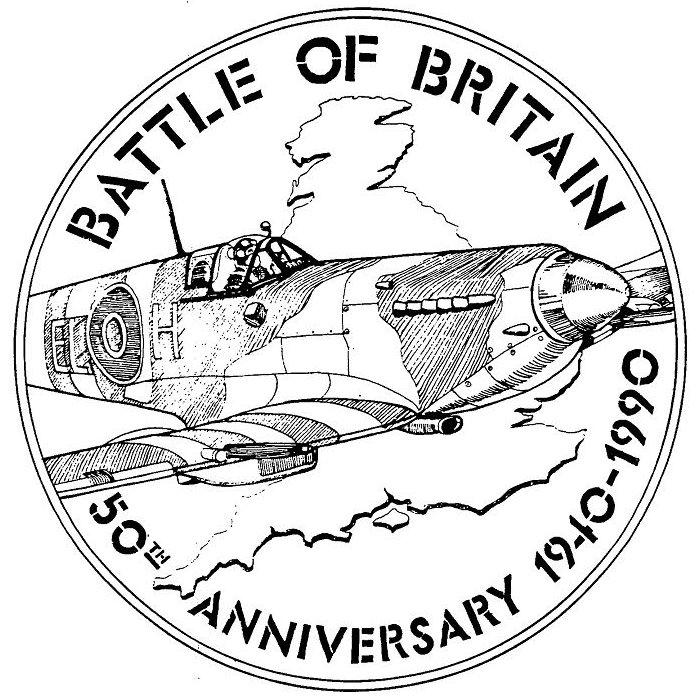 |
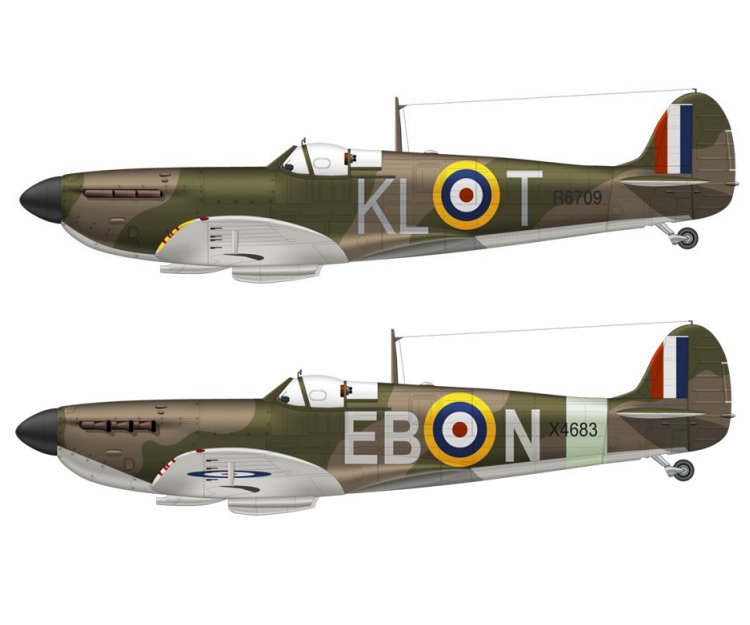 |
|
Note that the squadron code
on the initial design is EL and on the coin itself is for No. 54 Squadron RAF (KL Sep 1939 - Jun 1942). |
|
| The Initial Design |
|---|
 |
 |
| Note that the squadron code
on the initial design is EL and on the coin itself is for No. 54 Squadron RAF (KL Sep 1939 - Jun 1942). |
| 90th Birthday of Queen Mother | ||
|---|---|---|
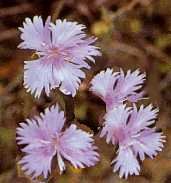 |
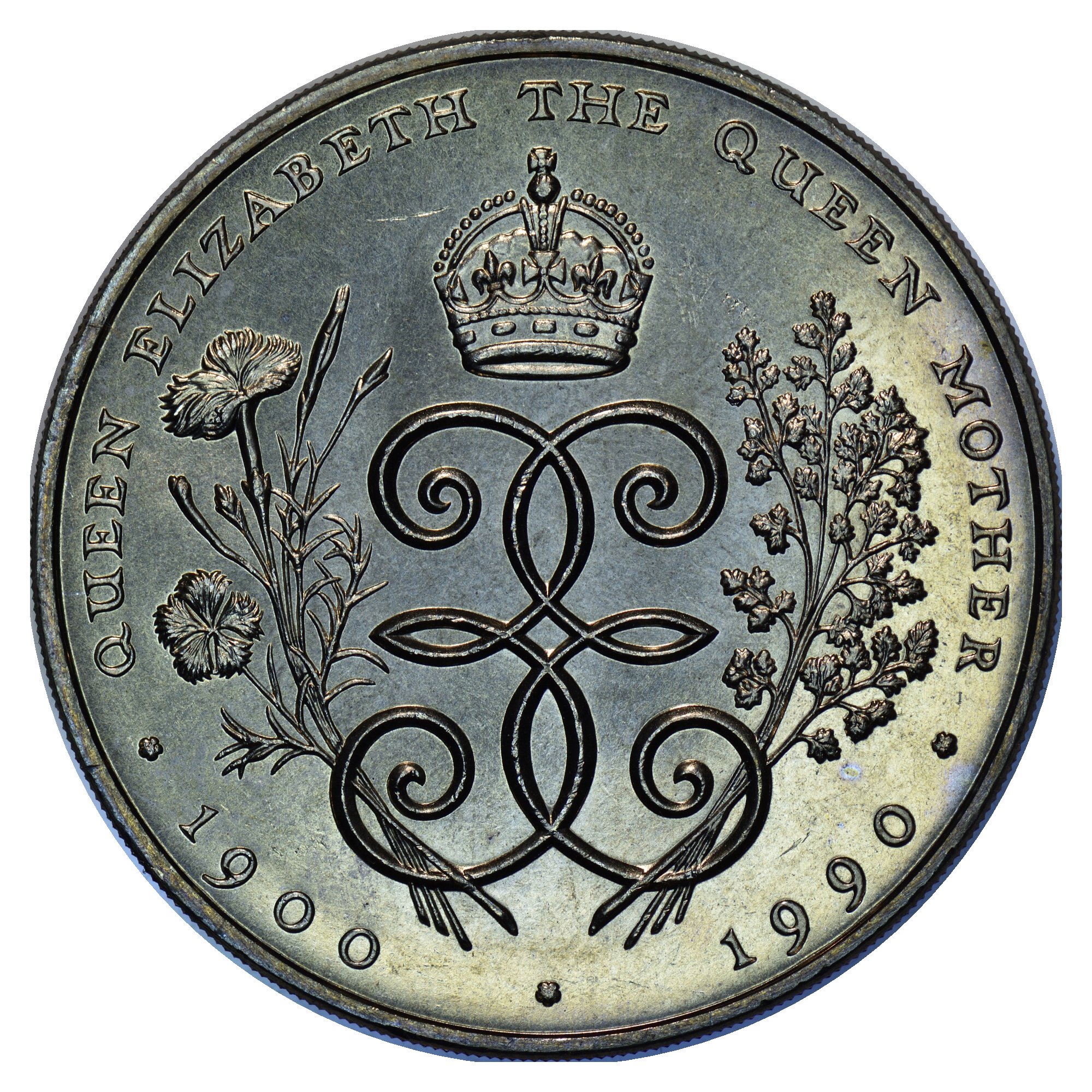 (click on image to enlarge) |
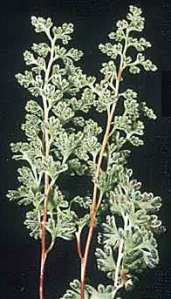 |
YEAR KM diameter
1990 83 38.61
The reverse of this coin features an exquisite engraving of two of Jersey's most beautiful flowers,
the Jersey Pink, Dianthus gallicus, and Jersey Fern, Anogramma leptophylla, linked by Her Majesty's personal cypher, E for Elizabeth. The obverse
carries Raphael Maklouf's renowned engraving of the Queen.
| 40th Anniversary of the Coronation (click on image to enlarge) |
|---|
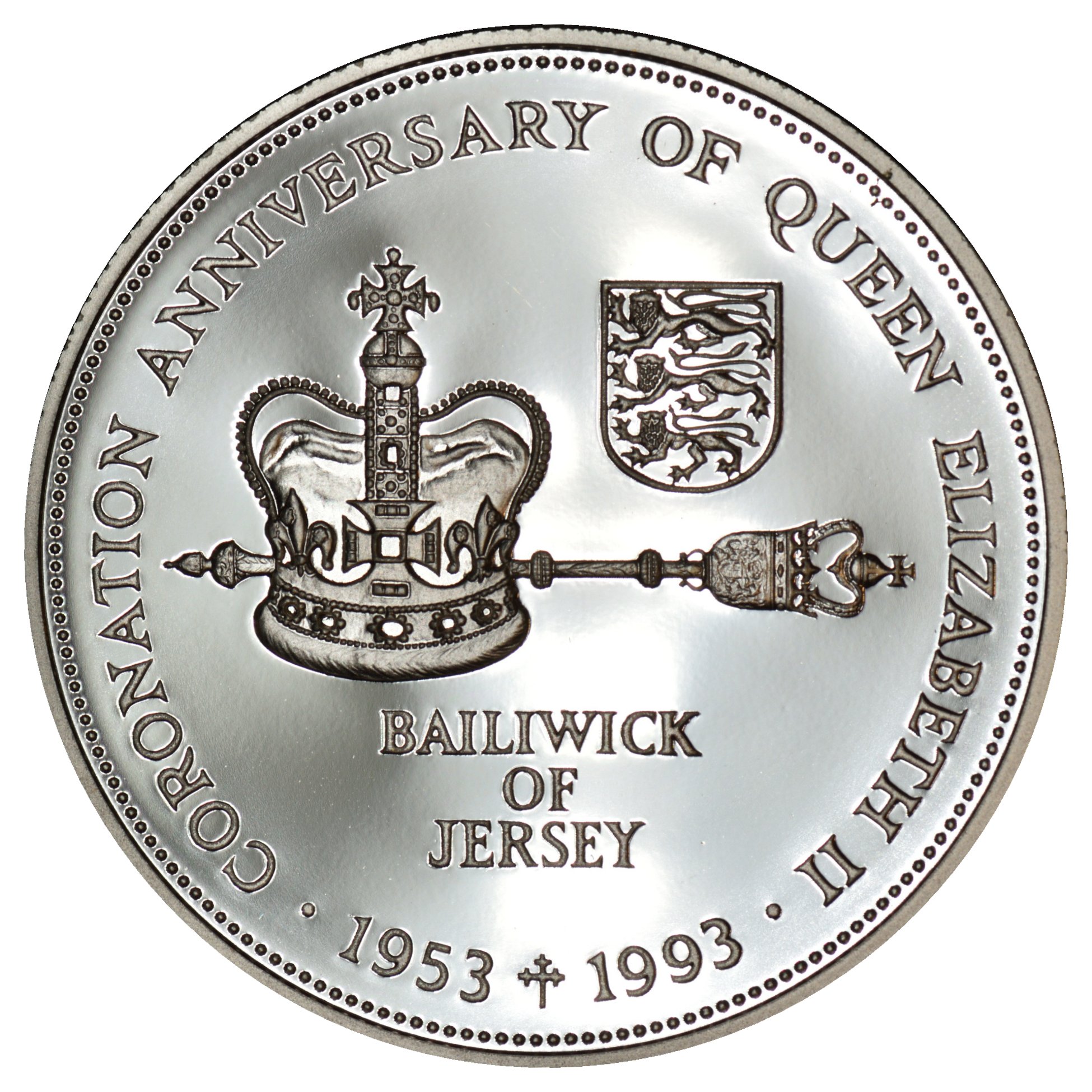 |
YEAR KM diameter
1993 89 38.6
The reverse of this exquisite coin, modeled in the Royal Mint Engraving Department, depicts familiar items of
Royal regalia. St. Edward's crown - used in the coronation of almost all British Sovereigns since the coronation of Charles II in 1661 - is
superimposed on a ceremonial Mace which is chased and ornamented with emblems of the United Kingdom. Above this is the Coat of Arms of Jersey.
| 50th Anniversary of Liberation (click on image to enlarge) |
|---|
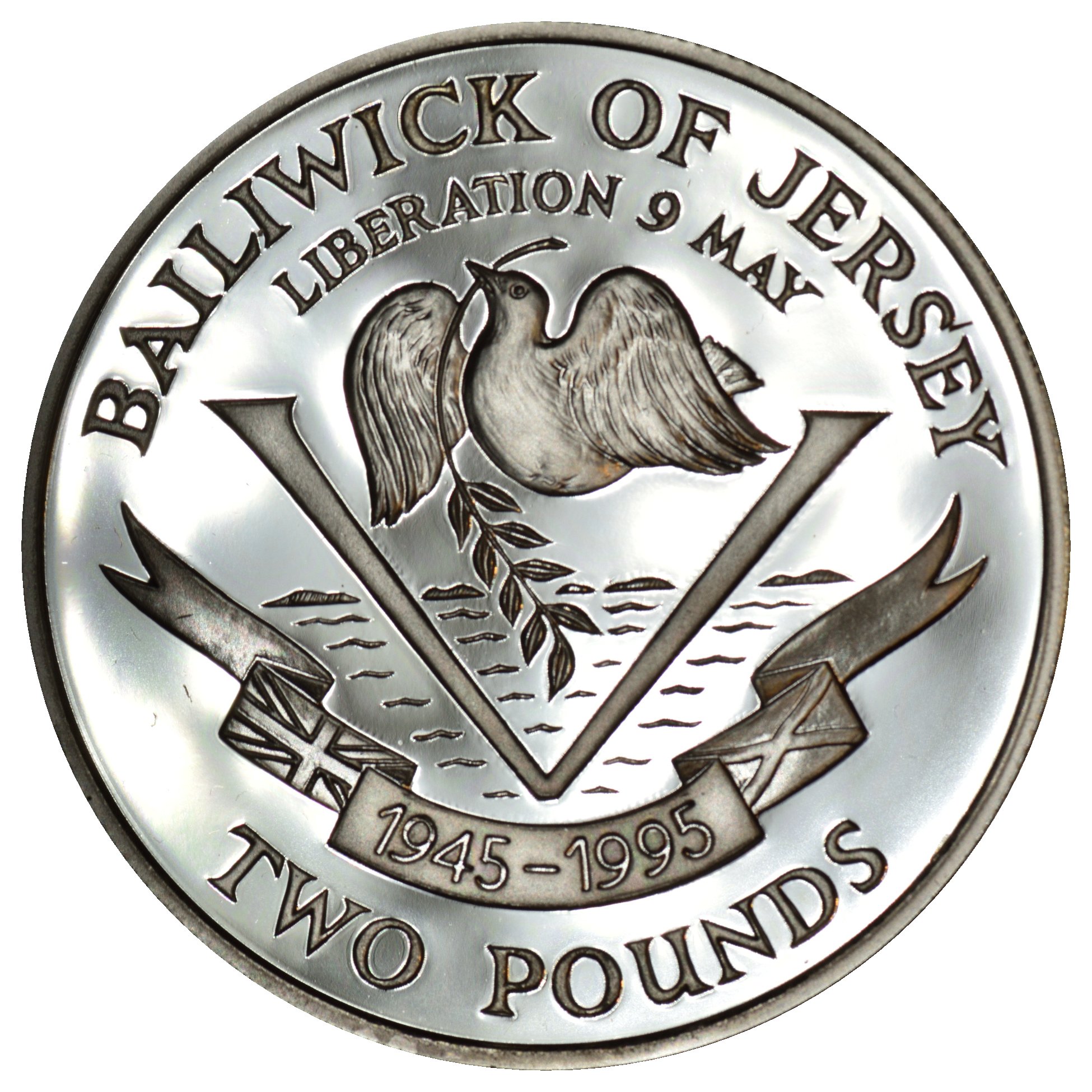 |
YEAR KM diameter
1995 92 38.6
The Channel Island of Jersey marked the 50th anniversary of its liberation with five coins. The reverse of this
particular coin was designed by the
Royal Mint engraver Robert Elderton to celebrate the end of German occupation. The other four coins were issued in
gold.| Queen's 70th Birthday (click on image to enlarge) |
|---|
 |
YEAR KM diameter
1996 97 38.6
To honor the Queen's seventieth birthday, the States of Jersey issued a commemorative two-pound coin.
The reverse design by Norman Sillman shows a delightful birthday bouquet of Jersey lilies, an autumn flowering plant that, with its pink, funnel shaped blooms, is indigenous to the island of Jersey.
| 25th Wedding Anniversary (click on image to enlarge) |
|---|
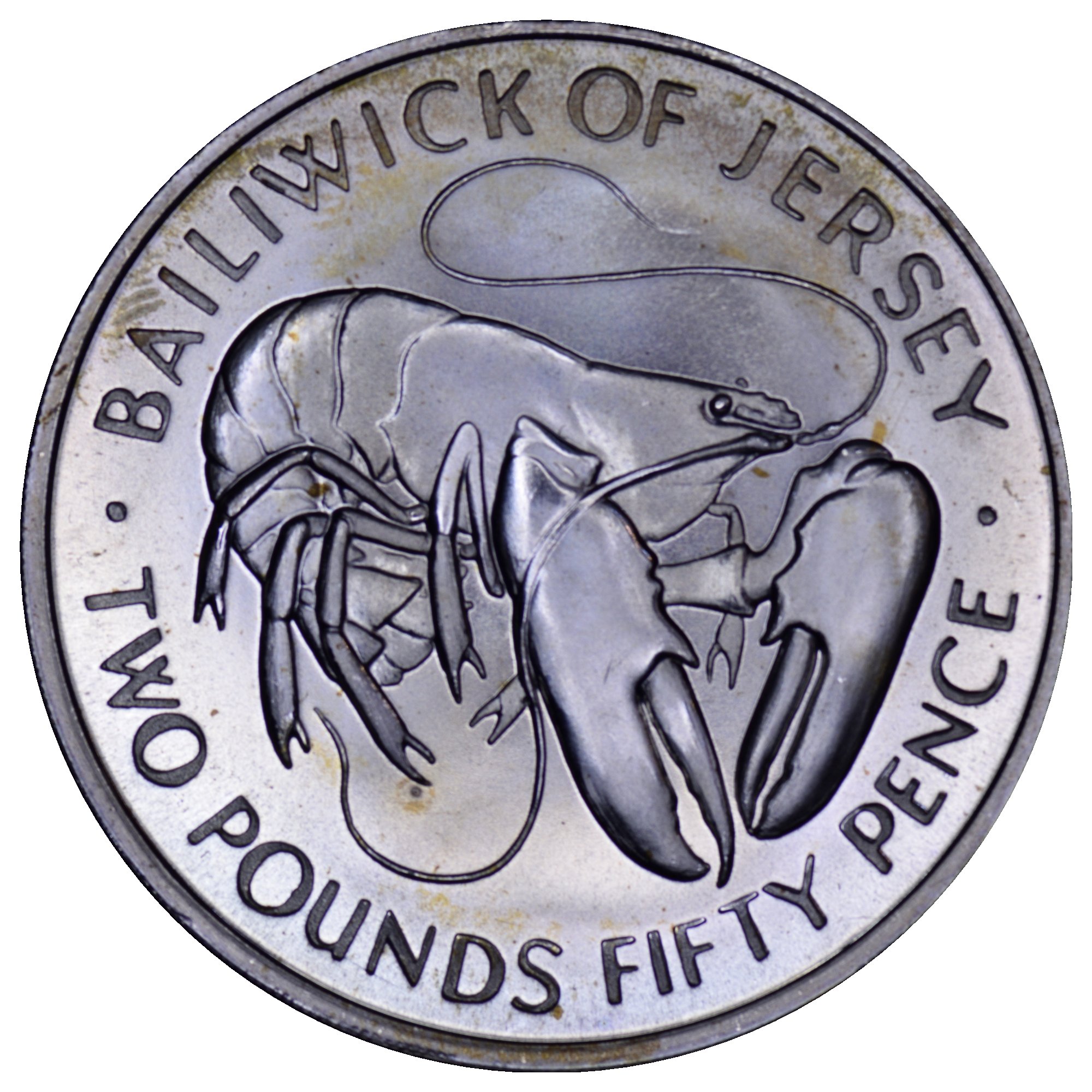 |
YEAR KM diameter
1972 38 40.10
The fourth and last silver coin in the Silver Wedding 1972 commemorative series.
Pictured is a Lobster, (Homarus Vulcaris). The lobster
is found along the rocky coast and in the seas around Jersey. It is a principal quarry of the local
fisherman, who has a large export trade. A Jersey law of 1938 (Loi sur la Pêche et la Vente de Poisson)
prescribes the minimum size of lobster which can be taken.
| 50th Anniversary of the Battle of Britain (click on image to enlarge) |
|---|
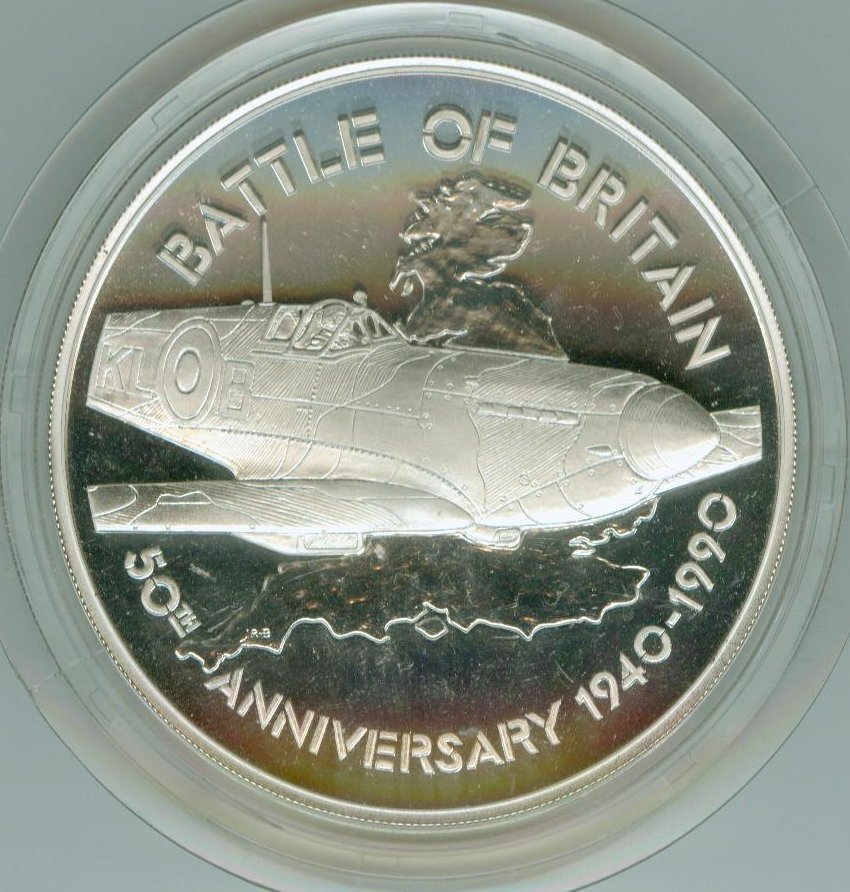 |
YEAR KM diameter
1990 78 65.00
This huge coin weighs 4.6215 oz. of .999 fine silver and has a similar design as the corresponding two pounds coin.
| 50th Wedding Anniversary (click on image to enlarge) |
|---|
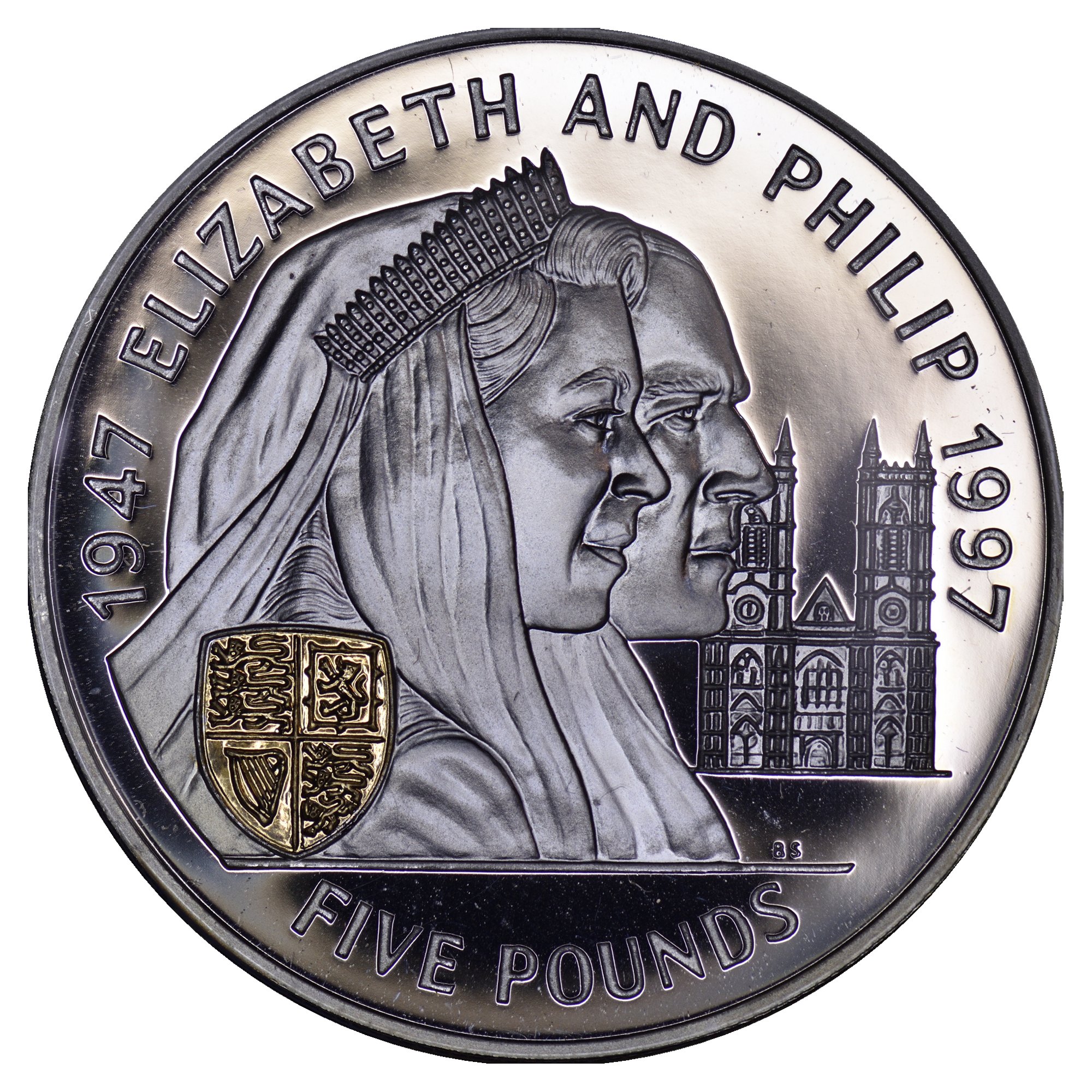 |
YEAR KM diameter
1997 100 38.6
In celebration of the 50th Wedding Anniversary of Her Majesty the Queen and Prince Philip,
the British Royal Mint offered an international collection of sterling silver coins struck in
proof quality. The coins featured attractive reverse designs by some of the most eminent
numismatic artist of today, including Leslie Durbin, Philip Nathan, John Savage, and
Barry Stanton (the designer of the coin for Jersey). Among the events captured are the
royal engagement, the wedding ceremony, the Coronation and many overseas visits, together
with the couple's mutual love of equestrian sports.
| The New Millennium (click on image to enlarge) |
|---|
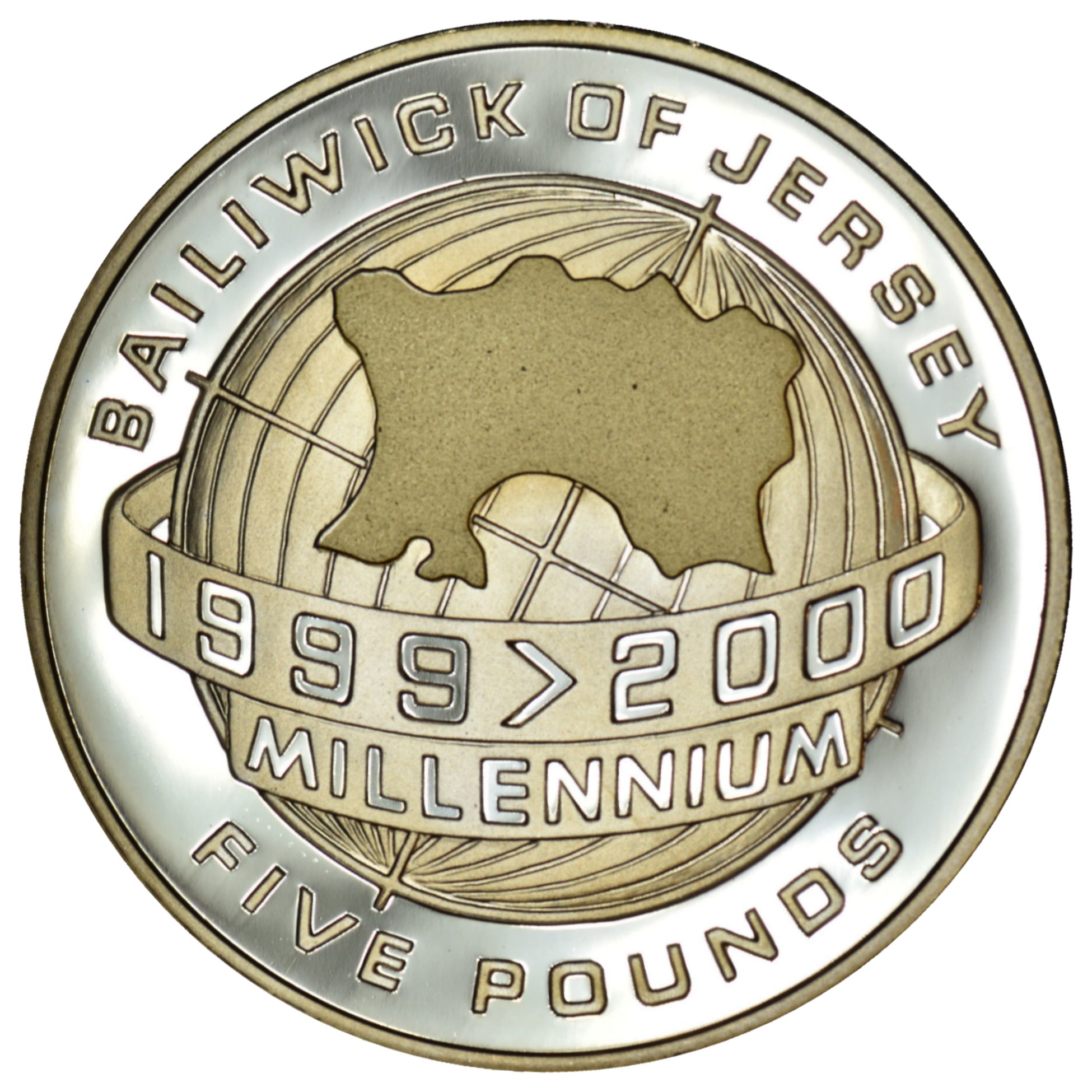 |
YEAR KM diameter
2000 109 38.6
Prominently positioned on a world globe, a golden silhouette of the island of Jersey
acknowledge the imminent arrival of the new millennium with a celebratory banner
highlighting the historic passage of time from 1999 to 2000. The reverse design is
by Leslie Lindsay, the designer of the 1984 Isle of Man Angel gold coins. |
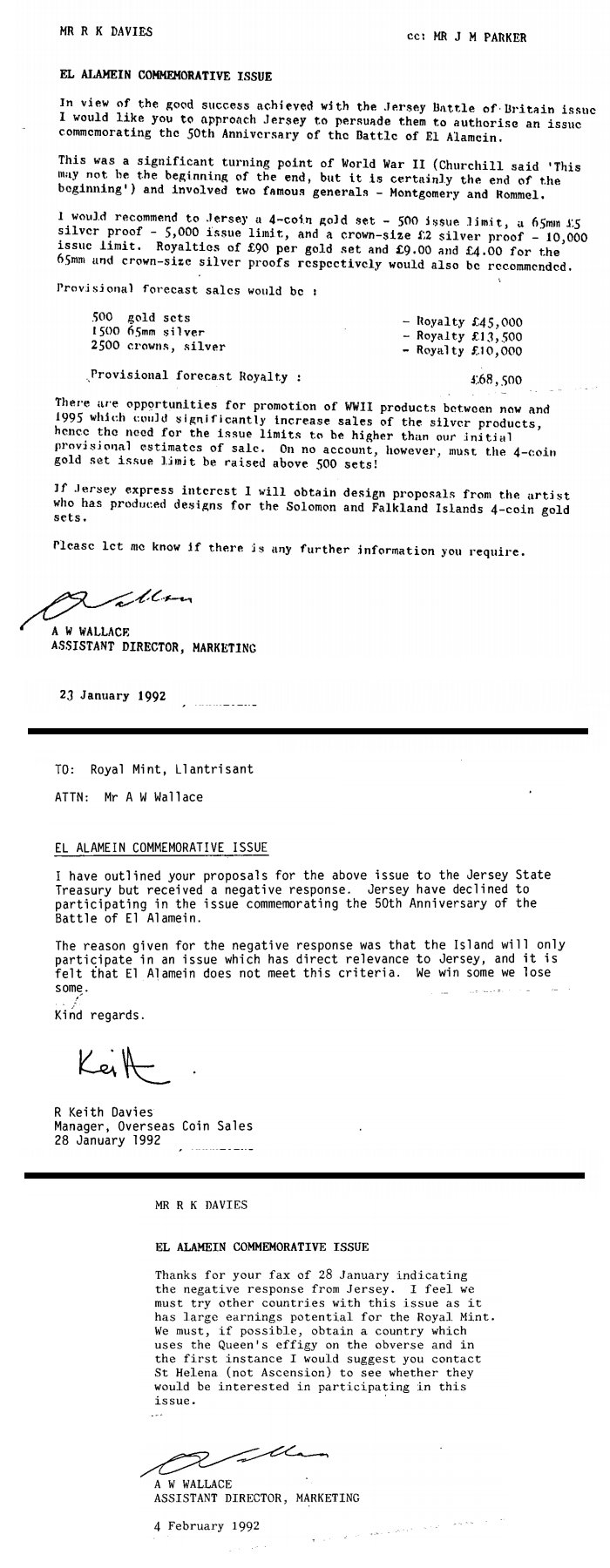 |
| Jersey 2009 Great Battles Commemoratie |
|---|
 |